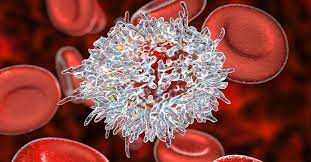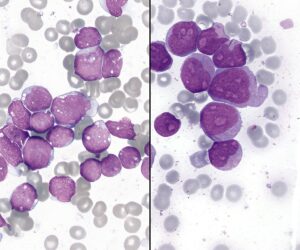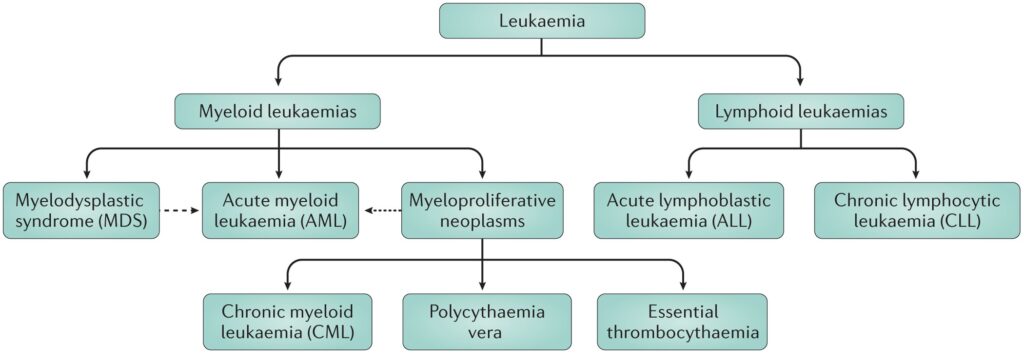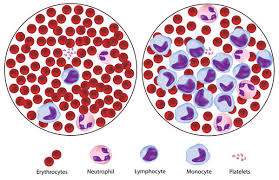
Leukaemia
- Leukaemia ek tarah ka cancer hai jo hematopoietic tissues, jaise bone marrow se originate hota hai.
- Ismein abnormal white blood cells (leukocytes) ka overproduction hota hai.
- Ye leukemic cells immature aur dysfunctional ho sakte hain, jo red blood cells, white blood cells, aur platelets ki normal production ko rok dete hain.
- Is wajah se leukaemia ke patients ko kai symptoms ho sakte hain, jaise anemia, infections ka zyada hona, aur bleeding complications.

Pathophysiology
Leukaemia mein, hematopoietic stem cells mein genetic mutations ke wajah se leukemic cells ka clonal proliferation hota hai. Ye mutations mein shamil ho sakte hain:
-
Oncogenes: Ye wo genes hote hain jo mutate ya overexpress hote hain aur cell growth aur division ko promote karte hain.
-
Tumor Suppressor Genes: Ye wo genes hote hain jo normally cell division ko inhibit karte hain ya apoptosis promote karte hain. Inmein mutations se uncontrolled cell proliferation hoti hai.
-
Epigenetic Changes: Ye wo modifications hain jo gene expression ko affect karte hain bina DNA sequence ko change kiye, jo leukaemic phenotype ko contribute karte hain.
In abnormal cells ka bone marrow mein accumulation bone marrow failure ka kaaran banta hai, jo ki kuch conditions ko lead karta hai:
-
Anemia: Red blood cells ki production na hone ke wajah se.
-
Thrombocytopenia: Platelets ki kam production, jo bleeding ka risk badhata hai.
-
Leukopenia: Leukocyte maturation ineffective hone ki wajah se infections ka risk badhta hai, chahe white blood cell count high ho.
Clinical Presentation
Leukaemia ki clinical presentation type aur stage ke hisaab se kaafi vary karti hai, lekin commonly shamil hoti hain:
-
Fatigue aur Weakness: Anemia ki wajah se.
-
Fever aur Night Sweats: Underlying infections ya cytokine release ke wajah se.
-
Weight Loss: Advanced cases mein dekhne ko milta hai.
-
Bone Pain: Bone marrow infiltration ke wajah se.
-
Lymphadenopathy aur Splenomegaly: Lymph nodes aur spleen ka badhna, khas kar lymphoid leukemias mein.
-
Bleeding aur Bruising: Thrombocytopenia ke wajah se, jo easy bruising, petechiae, ya bleeding gums ka kaaran banta hai.
Classification of Leukemia
1. Classification Based on Progression Speed:
-
Acute Leukemia: Jaldi immature cells (blasts) ka increase hota hai. Symptoms bhi jaldi develop hote hain.
-
Acute Lymphoblastic Leukemia (ALL): Bachon mein common hota hai, par adults ko bhi ho sakta hai. Isme lymphoblasts ka proliferation hota hai, jo chromosomal abnormalities jaise Philadelphia chromosome ya chromosome 21 ki alterations ke saath hote hain.
-
Acute Myeloid Leukemia (AML): Adults mein zyada common hai. Ye myeloid lineage ko involve karta hai, aur multiple subtypes hain jo genetic abnormalities aur lineage ke base pe classified hote hain.
-
-
Chronic Leukemia: Yeh dheere dheere progress karta hai, aur patients apne normal function ko zyada samay tak maintain kar pate hain.
-
Chronic Lymphocytic Leukemia (CLL): Adults mein sabse common type hai, jisme chhote, mature lymphocytes ka accumulation hota hai. Initially yeh asymptomatic hota hai aur routine blood tests ke dauraan diagnose hota hai.
-
Chronic Myeloid Leukemia (CML): Isme Philadelphia chromosome hota hai, jo chromosomes 9 aur 22 ke beech translocation ke wajah se hota hai (BCR-ABL fusion). Ismein splenomegaly aur leukocytosis dekhne ko milta hai.
-
2. Classification Based on Cell Type:
-
Lymphoid Leukemias: Yeh lymphoid progenitor cells se aati hain.
-
ALL: High blast counts ke saath present hota hai aur jaldi treatment ki zarurat hoti hai kyunki disease rapid progress karti hai.
-
CLL: Normally achi prognosis hoti hai, lekin kabhi kabhi aggressive forms mein transform ho sakta hai.
-
-
Myeloid Leukemias: Yeh myeloid progenitor cells se aati hain.
-
AML: Subtypes ke hisaab se diverse clinical features ho sakte hain, aur treatment regimens bhi specific genetic mutations ke hisaab se vary karte hain.
-
CML: Ismein chronic, accelerated, aur blast phases hote hain, aur treatment phase ke hisaab se evolve hota hai.
-
Other Subtypes of Leukemia
-
Hairy Cell Leukemia: Rare form of CLL hai, jisme “hairy” appearance wale B-cells hoti hain. Yeh splenomegaly aur specific cytopenia ke pattern ke saath present hota hai.
-
Acute Promyelocytic Leukemia (APL): Yeh AML ka subtype hai, jo chromosome 15 par promyelocytic leukemia (PML) gene se related hota hai. Yeh treatment mein all-trans retinoic acid (ATRA) aur arsenic trioxide ka use karti hai.
Laboratory Investigations 
-
Complete Blood Count (CBC): Yeh leukaemia ke assessment mein foundational test hota hai.
-
WBC: Leukocytosis acute leukemias mein dekha jata hai blasts ke increase hone ki wajah se. Leukopenia chronic leukemias ya advanced disease mein ho sakta hai.
-
Hemoglobin (Hb): Usually low, indicating anemia.
-
Platelet Count: Zyada tar leukaemia types mein decreased hota hai.
-
-
Peripheral Blood Smear: Blood cells ke morphology ko evaluate karta hai.
-
Blasts: Agar ≥20% blasts present hain, toh acute leukaemia ka indication hota hai.
-
Cellular Morphology: Specific features identify karte hain:
-
Auer Rods: AML mein hota hai, jo myeloid differentiation indicate karta hai.
-
Smudge Cells: CLL ke liye classic hote hain.
-
Lymphoblasts: ALL ka indication hota hai.
-
-
-
Bone Marrow Aspiration and Biopsy: Diagnosis aur classification ke liye critical hai.
-
Bone Marrow Aspirate: Cellularity ko evaluate karta hai aur cytological examination ke through blasts ka percentage assess karta hai.
-
Bone Marrow Biopsy: Core sample jo marrow ki architecture aur leukemic cells ke infiltration ka extent batata hai.
-
-
Cytogenetic Analysis: Leukaemia ke diagnosis, classification, aur prognosis ke liye essential hai.
-
Karyotyping: Chromosomal abnormalities jaise translocations ya deletions ko identify karta hai.
-
FISH: Genetic abnormalities aur fusion genes ko detect karta hai.
-
-
Immunophenotyping: Leukemic cells ko surface antigens ke basis pe classify karta hai.
-
Molecular Testing: Diagnosis aur monitoring mein important hai.
-
PCR: Specific mutations ya fusion genes ko detect karta hai.
-
NGS: Genetic mutations aur alterations ka comprehensive profile deta hai.
-
Prognosis and Management
Leukaemia ka prognosis aur management kai factors pe depend karta hai, jaise type, genetic abnormalities, patient ki age, aur health. Treatment options mein shamil hain:
-
Chemotherapy: Acute leukemias ka main treatment hota hai.
-
Targeted Therapy: Jaise TKIs for CML (imatinib), aur monoclonal antibodies for CLL (rituximab).
-
Stem Cell Transplantation: High-risk leukaemia ya relapse cases mein consider kiya jata hai.
-
Supportive Care: Transfusions, antibiotics, aur growth factors shamil hote hain.